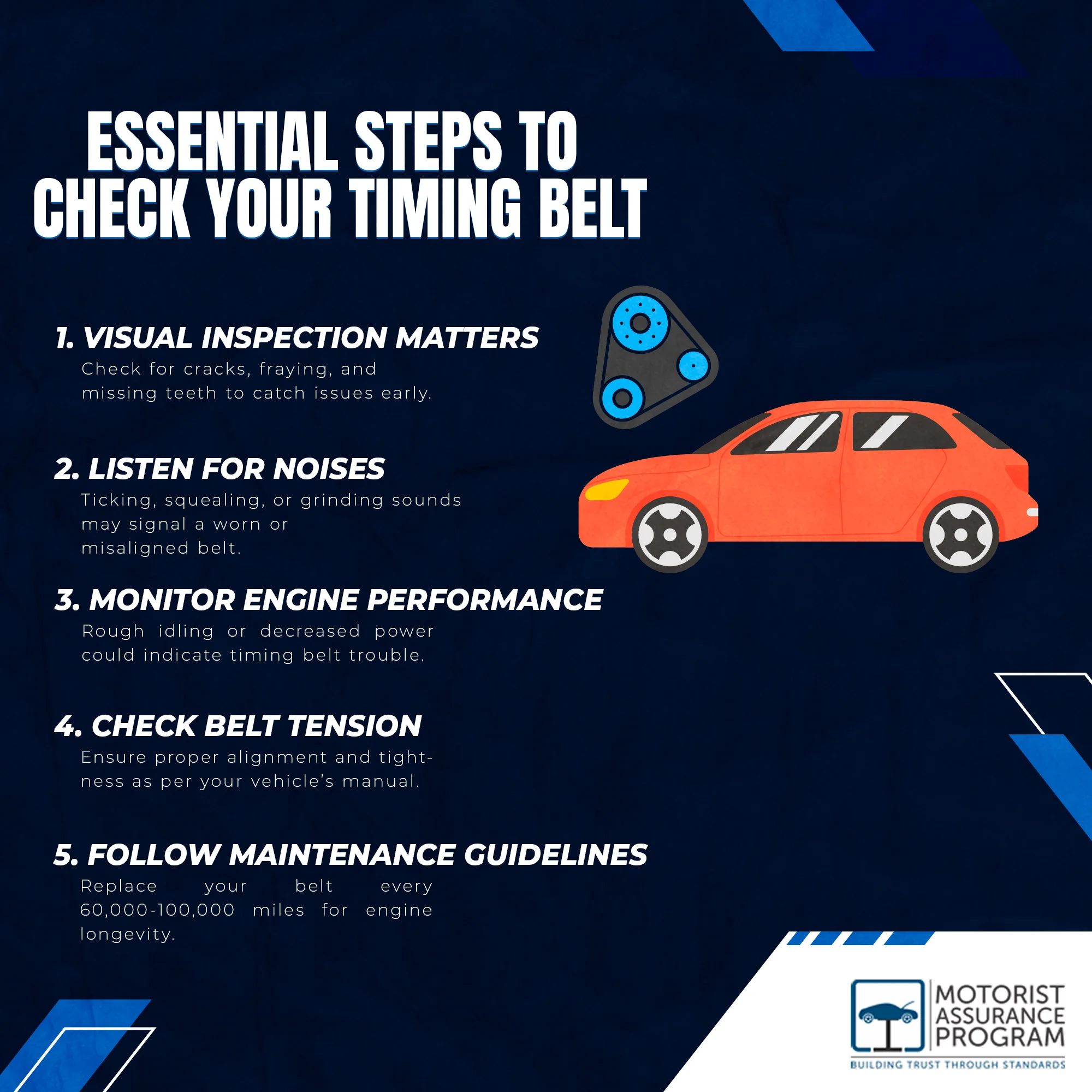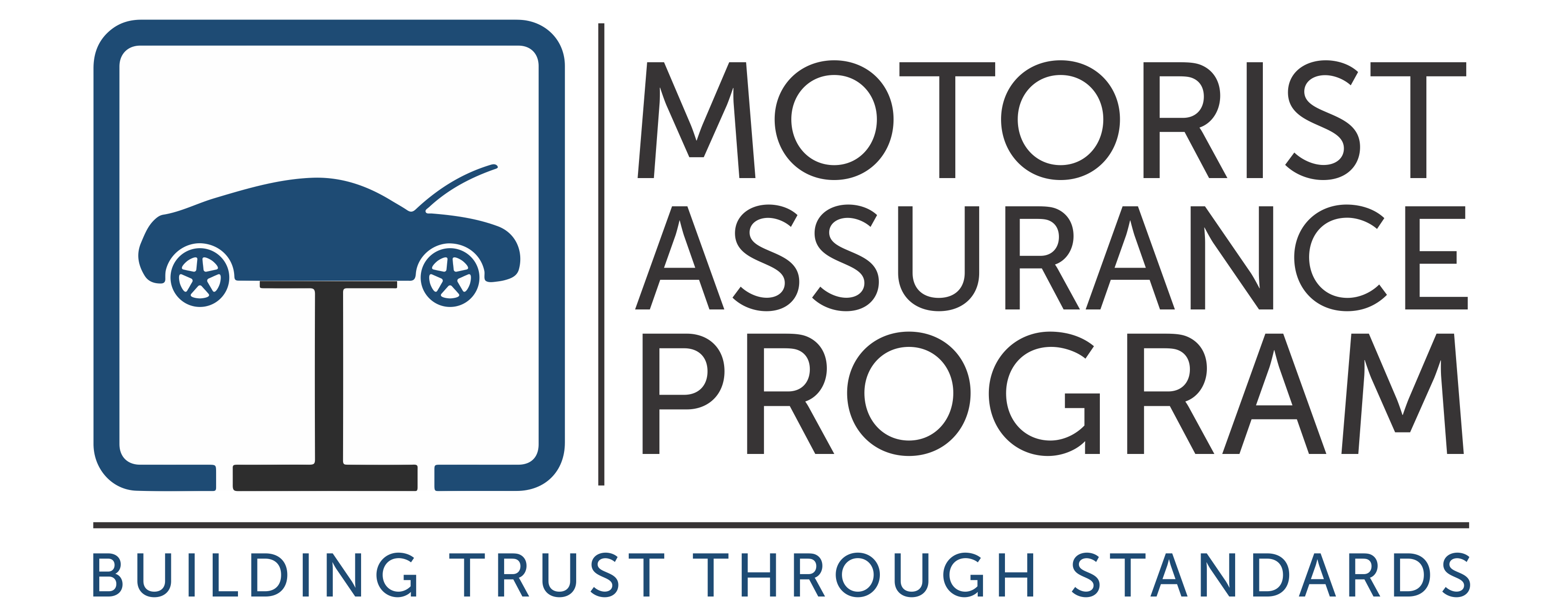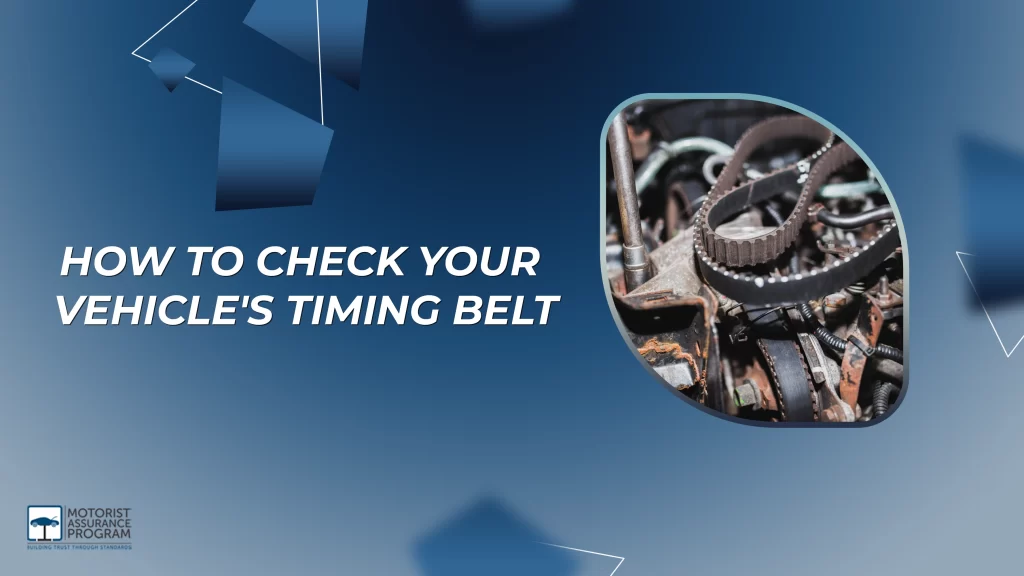To check your vehicle’s timing belt, start with a visual inspection for cracks, fraying, or missing teeth. Listen for any unusual engine noises, like ticking or squealing, which could indicate wear or misalignment. Monitor your engine’s performance; rough idling or decreased power might signal timing belt issues. Finally, look for external signs such as tension and alignment problems. If you want to know more about maintaining your timing belt, keep going!

Key Takeaways
- Perform a visual inspection for cracks, fraying, or missing teeth on the timing belt.
- Listen for unusual engine noises, such as ticking or squealing, indicating potential wear or misalignment.
- Monitor engine performance for rough idling, decreased power, or stalling as signs of timing belt issues.
- Check the timing belt tension and alignment according to your vehicle manual to ensure proper operation.
- Regularly consult your vehicle manual for specific maintenance recommendations and replacement intervals for the timing belt.
Understanding the Importance of Timing Belts
Understanding the vital role of timing belts is essential for every vehicle owner. These belts synchronize the engine’s camshaft and crankshaft, ensuring your vehicle runs smoothly. Neglecting them can lead to serious engine damage, which can be costly and inconvenient. That’s why understanding timing belt maintenance is vital.
Visual Inspection for Wear and Tear for Timing Belt Replacement
When it comes to ensuring your timing belt’s longevity, a visual inspection is essential. Start by checking the timing belt for any signs of wear and tear. Look for cracks, fraying, or shiny spots, which may indicate excessive wear. You should also check for any missing teeth on the belt, as this can lead to severe engine damage. If you’re unsure how to check the timing belt on your car, consult your vehicle’s manual for specific guidance on the inspection process. Regularly checking the timing belt can help you catch issues early and avoid costly repairs down the line. If you notice any significant wear, consider replacing the belt before it fails to keep your engine running smoothly.
Listening for Unusual Engine Noises
After visually inspecting your timing belt for any signs of wear, it’s important to pay attention to how your engine sounds. Listening for unusual engine noises can be a key indicator of timing belt issues. If you hear a ticking, squealing, or grinding noise, it might suggest that your timing belt is wearing out or has become misaligned. These sounds can signal that the belt isn’t functioning properly, which could lead to severe engine damage. Additionally, if your check engine light timing belt comes on, it’s a good idea to investigate further. Ignoring these noises and warning signs can lead to costly repairs, so make sure to address any concerns promptly. Your engine will thank you!
Monitoring Engine Performance Issues for Timing Belt Replacement
If you’re noticing a decline in your engine’s performance, it could be time to evaluate the condition of your timing belt. A worn or damaged vehicle timing belt can lead to a variety of issues, including rough idling, decreased power, or even stalling. These symptoms often indicate that the timing belt may not be functioning properly, affecting the engine’s overall performance. Additionally, if your check engine light comes on after a timing belt replacement, it’s essential to address it immediately. Ignoring these signs can lead to more severe engine damage. Regular monitoring of your engine’s performance can help you catch timing belt issues early, ensuring a smoother and more reliable driving experience.
Checking for External Signs and Symptoms
To effectively assess the condition of your vehicle’s timing belt, it’s crucial to check for external signs and symptoms that could indicate wear or damage. Start by visually inspecting the belt for cracks, fraying, or glazing, as these can signal it’s time for a replacement. Listen for any unusual noises when the engine is running; a noisy timing belt could mean it’s wearing out. When checking the timing chain, look for tightness and alignment issues. If you’re unsure about checking the tension of your timing belt, refer to your vehicle’s manual or seek advice from a qualified mechanic. Staying proactive in identifying these signs can prevent costly repairs down the road and guarantee your engine runs smoothly.
Frequently Asked Questions
How Often Should I Replace My Timing Belt?
You should replace your timing belt every 60,000 to 100,000 miles, depending on your vehicle’s make and model. Always consult your owner’s manual for specific recommendations to guarantee your engine runs smoothly and efficiently.
What Tools Do I Need to Check the Timing Belt?
You might think checking a timing belt is easy, but you’ll need some specific tools. Grab a socket set, a wrench, and a flashlight to inspect it properly. These are essential for a thorough assessment.
Can I Check the Timing Belt Without Professional Help?
You can check the timing belt without professional help, but it requires some knowledge and tools. If you’re confident in your skills, follow guidelines carefully to avoid any mistakes that could lead to costly repairs.
What Happens if I Ignore Timing Belt Issues?
If you ignore timing belt issues, you risk severe engine damage. A snapped belt can lead to piston and valve collisions, resulting in costly repairs. It’s essential to address any signs of wear promptly.
Are There Specific Brands Known for Reliable Timing Belts?
You might think all timing belts are the same, but they’re not. Brands like Gates, Dayco, and Continental are known for reliability. Investing in a quality belt guarantees your engine runs smoothly and lasts longer.
Conclusion
In summary, keeping an eye on your timing belt is essential for your vehicle’s health. Did you know that about 90% of timing belt failures occur due to lack of maintenance? By regularly inspecting it and addressing any signs of wear, you can avoid being part of that statistic. Remember, a simple check can save you from costly repairs and keep your engine running smoothly. Stay proactive, and your car will thank you for it!


